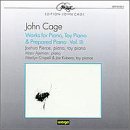| All Artists: Cage, Joshua Pierce Title: Works for Piano & Prepared Piano 3 Members Wishing: 3 Total Copies: 0 Label: Wergo Germany Release Date: 12/8/1993 Album Type: Import Genre: Classical Styles: Ballets & Dances, Ballets, Forms & Genres, Short Forms, Historical Periods, Modern, 20th, & 21st Century, Instruments, Keyboard Number of Discs: 1 SwapaCD Credits: 1 UPC: 093046269029 |
Search - Cage, Joshua Pierce :: Works for Piano & Prepared Piano 3
 | Cage, Joshua Pierce Works for Piano & Prepared Piano 3 Genre: Classical
|
Larger Image |
CD Details |
CD ReviewsCage's piano with and without the screws and bolts - imagina Discophage | France | 10/20/2007 (5 out of 5 stars) "Toy Pianos seem not as easy to find these days as they once were, before the invasion of electronics and plastic instruments with awful hard rock-and-roll pre-recorded sounds - a parents' nightmare, a gift that'll make your nephew happy but NOT your sister or brother. This had left me in great frustration as I had been dearly wanting to offer one to my little toddler - and possibly to myself. So I leaped with joy this summer when I chanced upon one in a toy store while on vacation. Spread the news: THEY'RE BACK!
John Cage was ever an experimenter in piano sounds, and an arch-provocateur as well, so it comes as no surprise that he composed not only for the famous prepared piano, but also for toy piano. The tinny sound of the toy piano isn't so far after all from that of a prepared piano, and Cage must have revelled sitting in front of the tiny thing during the Merce Cunningham dance performances for which it was written in 1948, or later the concert premiere in New York in 1960. As he inscribed on the score that the composition could be played both on toy piano and on a normal piano, it was a nice idea of Joshua Pierce to give both versions, opening and closing the disc. One can hear that the apparently simple textures of the toy piano (a lot of it plays on only five white notes, and the composition is really a study on child-like simplicity and restricted keyboard range, likening it to some of Bartok's easiest Mikrokosmos) are not so simple after all when played on the normal one ("grown-up", the liner notes call it), with in particular interesting play on the resonance obtained by maintining keys depressed while hitting on others, which doesn't come out too well on the toy instrument (but the noise of its mechanism certainly does). I'm not so convinced with Music for Amplified Toy Pianos, which is one of those "experimental" scores of the composer in which much is left to chance. Here, the score results from superimposing 8 transparent sheets in any order, and can be performed by any number of toy pianos and accompanying percussion. But to me it sounds only like a tinny klonk here, a tinny klonk there and a few automobile horn honks in between. It is particularly interesting to hear "The Seasons", written in 1947 for another Cunningham ballet, as it is, for once, scored for "normal", e.g. unprepared piano. Hearing the Sonatas and Interludes I often get the impression that the music is really only about the strange and arresting sounds of the prepared piano, but that there is not much beyond that: take off all the pins and bolts, screws, rubber pieces and all the objects that "encumber" the strings, and not much would be left, ditty-like music so simplistic as to leave one unquenched. Well, in a way, this is it: "The Seasons" is the music of Cage without the sounds of the prepared piano. And, much to my surprise, I find it actually quite convincing. In some pieces you hear the limps and the rhythmic bite and the dreamy mood of the Sonatas (tracks 4, 5, 10, 11). The atmosphere is somewhere between the stern style of Copland's Piano Sonata and Feldman's minimalist piano music. In his simutaneous and pounding use of extreme low and extreme high registers, Cage's normal piano at times almost sounds prepared (track 11). The music's terse simplicity also brings Satie - whom Cage much admired - to mind (again try track 11) as well as Cage's own String Quartet, but one is also surprised to encounter harmonies evocative of Debussy and French impressionism (track 7). But the true masterpiece here is "A Book of Music" for two prepared pianos. Not being a specialist of Cage, I had thought the Sonatas and Interludes were his first really major work for prepared piano. But this composition for two pianos was composed in 1944 for the famous Gold and Fizdale piano duet, two years before the first Sonatas. The liner notes call it "possibly Cage's magnum keyboard opus" and I agree. Sure enough, it starts very much like the Sonatas and Interludes : apparently simple, gamelan-sounding, ritualistic. But then begins the second part (track 15) and the music becomes very agitated, virtuosic, jazzy, belying the notion that Cage's music is "simple". Actually, with all the busy activity and complex rhythmical interplay, I never felt as much as here Cage's proximity to Nancarrow. The recordings were made between 1976 and 1989 (no other precisions given). They sound excellent. Good liner notes. Now I'll look for the score to "Suite for Toy Piano" and try and play it on my kid's toy piano - if he lets me. " |

 Track Listings (18) - Disc #1
Track Listings (18) - Disc #1